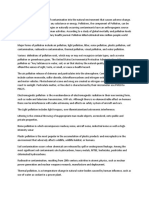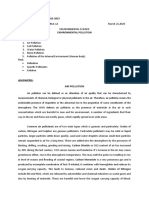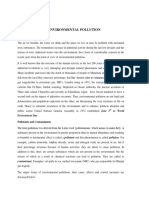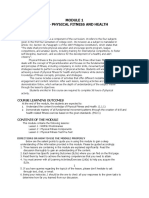Seminar Work: Subject: Pollution and Environment
Seminar Work: Subject: Pollution and Environment
Uploaded by
Toskic JovanCopyright:
Available Formats
Seminar Work: Subject: Pollution and Environment
Seminar Work: Subject: Pollution and Environment
Uploaded by
Toskic JovanOriginal Title
Copyright
Available Formats
Share this document
Did you find this document useful?
Is this content inappropriate?
Copyright:
Available Formats
Seminar Work: Subject: Pollution and Environment
Seminar Work: Subject: Pollution and Environment
Uploaded by
Toskic JovanCopyright:
Available Formats
Agricultural Faculty University of Belgrade Nemanjina 6 Zemun
SEMINAR WORK
Subject : Pollution and Environment
Professor, Katarina Smakic
Student,Marija
Belgrade, 21 st mart 2007
Introduction
Environmental pollution is addition of any substance (e.g. carbon dioxide, plastic) of form of energy (e.g. heat, sound radioactivity) to the environment faster than the environment can accommodate it by dispersion, brake down, recycling or storage in some harmless form. There are two kinds of pollutants. The first kind is not harmful in itself. For example, one of natural components of the atmosphere is carbon dioxide, but in concentrated form it can be fatal for animals and humans. On the other hand, there are some pollutants, for example radioactivity, which are harmful in any quantity even though they might also occur in nature. Pollution is not new phenomenon. It has accompanied mankind ever since they started to form permanent settlements. Unsanitary conditions in the ancient cities and in the cities during the Middle Ages, were often causing epidemics of various diseases. During the 19th century water and air pollution and the accumulation of solid wastes were problems of only large cities. But with industrialization and the increase in human population pollution has become universal problem. All forms of pollution are divided in three main kinds: pollution of air, water and land.
Pollution of air
Air pollution involves the release of gases, finely divided solids of finely dispersed liquid aerosols into the atmosphere at rates that exceed the capacity of atmosphere to dissipate them of dispose of them through incorporation into solid or liquid layers of biosphere. Air pollution may have natural causes. Dust storms in deserts, smoke from forest fires contribute to chemical and particulate pollution of the air. The most important natural source of air pollution is volcanic activity that releases great amounts of ash and toxic fumes into the atmosphere. Scientists think that it can cause climatic changes.
But far more serious is the pollution that is caused by humans: pollution caused by exhaust fumes from the automobile engines, fumes from factories... Some immediate consequences of air pollution are acid rains, respiratory diseases... Potentially even more dangerous are long term effects of air pollution like greenhouse effect. Greenhouse effect is caused by high concentration of carbon dioxide, to high for plants to remove it from the atmosphere or to be dissolved in the oceans. Like glass in a greenhouse greenhouse effect allows light rays from the Sun to pass through, but it does not allow heat rays generated when sunlight is absorbed by the surface of the ground to escape. This is causing increase in the temperature that leads to melting of the polar ice caps, raise of the sea level and flooding of the coastal areas of the world. The other hand, there is a possibility that the increase of carbon dioxide in the atmosphere could cause higher percentage of solar radiation that is reflected back into space. This may cause a lowering of the Earths surface temperature and, potentially, a new ice age. Another serious concern are holes in ozone layer. They are caused by chlorofluorocarbons emitted from, for example, refrigerators and other pollutants from rockets and supersonic aircraft. Ozone layer absorbs ultraviolet radiation from the Sun. Because of the decreased capacity of ozone layer to absorb there is an increase in ultraviolet radiation which is very dangerous and may cause skin cancer. Probably the most dangerous kind of pollution is radioactive pollution that can endanger the whole human kind and most of the animal species. There is tendency to control production of nuclear weapons and to stop testing of nuclear bombs. Nuclear power plants could also lead to nuclear catastrophe. Consequences of fire and partial meltdown in nuclear power plant in Chernobyl (1986) near Kiev were experienced in whole of northern and eastern Europe including Serbia.
Water pollution
Water pollution involves the release of substances into lakes, rivers and oceans. These substances become dissolved in water or deposited upon the bottom and accumulate to the extent that they endanger water ecosystems. It may also include release of radioactivity or heat, as in case of termal pollution. Water has the capacity to absorb, break down, or recycle some of those materials. Under normal circumstances amount of pollutants does not effect water ecosystems. The output of industries, agriculture and urban settlements generally exceeds capacity of water to recycle it. Main pollutants of water are industries whish discharge their waste into the water, but some indirect pollution is very important too. For example, fertilizers and pesticides from soil may end in water. But it also may happen that spillage of oil (or some other pollutant) from transporter ships pollute not only the water but soil too. Big pollutant of water are urban sewage systems, septic tanks and other organic waste.
When organic matter exceeds the capacity of water to recycle it may cause rapid growth of algae. When they die, the remains of dead algae is additional organic waste. Eventually, the water stays without oxygen. Anaerobic organisms then attack organic waste, releasing gases such as methane and hydrogen sulfide, which are harmful to the aerobic forms of life. The result is water that is filled with waste and that smells very unpleasant. Cleaning waters is very expensive long lasting process that often cant be 100 percent successful. For that reason prevention from further pollution is very important.
Land pollution
Land pollution involves accumulation of solid wastes on land, for example: used cars, cans, bottles, plastic, paper. Some of them cannot be broken down quickly and some (like plastic) cannot be broken down at all. There are a few methods of disposal other than the recycling but they are not entirely satisfactory. These methods include dumping waste in the ocean, which creates water pollution or a burning which creates air pollution. One of methods that still needs developing is landfill. A landfill is system of trash and garbage disposal in which the waste is buried between layers of earth to create artificial landscapes that are planted with various kinds of vegetation.
Responsibility and preservation of environment
Decisions that we make today will effect our future and the future of the generations to come. Some areas of Earth are damaged so badly by technological civilization that will be difficult if not impossible to restore. Therefore it is essential to change our behavior in order to save the environment and living conditions on Earth. Few days ago (on Saturday) U.N. climate change conference ended in Bali with a last-minute plan that is suppose to lead toward a new climate change treaty. Media described talks as emotional emphasizing discontent of delegates from other countries with U.S. objections to a specific upper limit of gas emissions. Bush administration refused to accept a plan backed by Europe and many other countries to cut their own greenhouse gas emissions by 25 percent to 40 percent below 1990 levels by the year 2020. Al Gore, this years Nobel prize winner said: My own country, the United States, is principally responsible for obstructing progress here in Bali. We all know that. We all know that. It was only after 11th- hour negotiations that delegates from 187 countries agreed to work for a new climate change treaty over the next two years. The U.S. which is the worlds leading greenhouse gas emitter, ahead of China, Russia and India, eventually
agreed to compromise. The delegates essentially agreed to negotiate a treaty by 2009. The agreement says significant cuts in emissions will be required of industrialized countries, but does not specify the size of those cuts or whether they will be mandatory. China and other developing countries also agreed for the first time to consider controlling the growth of their emissions, but that promise too is without any binding commitments. U.S. was the only major industrialized country to reject the Kyoto agreement on climate change, which is set to expire in 1012. Main reasons for this decision were economic reasons which still direct U.S. policy towards ecological issues. Environmental activists were not satisfied with this outcome of Bali conference.
You might also like
- Chemistry Unit Test Practice AnswersDocument6 pagesChemistry Unit Test Practice Answersapi-26385075333% (3)
- Policy NestleDocument12 pagesPolicy NestleShaeann Yee Loy100% (1)
- JUKI LU-2800 Series Engineer's ManualDocument143 pagesJUKI LU-2800 Series Engineer's ManualfilisavicNo ratings yet
- New Microsoft Office Word DocumentDocument14 pagesNew Microsoft Office Word Documentkunkulol100% (1)
- Chemistry ProjectDocument12 pagesChemistry ProjectAditya Kumar77% (13)
- Mba ProjectDocument42 pagesMba ProjectUday GowdaNo ratings yet
- The PollutionDocument30 pagesThe PollutionYannien Barrera SosaNo ratings yet
- Pollution Is TH-WPS OfficeDocument3 pagesPollution Is TH-WPS OfficeRonweL OcsonaNo ratings yet
- Marine Pollution Questions & AnswersDocument16 pagesMarine Pollution Questions & AnswersBasem Tam100% (2)
- Pollution: Ways To Reduce It in Our Community: Shinas College of TechnologyDocument4 pagesPollution: Ways To Reduce It in Our Community: Shinas College of TechnologyJorn TravoltaNo ratings yet
- Topic:-: Environmental ChemistryDocument18 pagesTopic:-: Environmental ChemistryKaran LachhwaniNo ratings yet
- The Environment: 16. Environmental ProblemsDocument5 pagesThe Environment: 16. Environmental ProblemsPiroska SzolnokiNo ratings yet
- Shri Krishna Public School EditedDocument29 pagesShri Krishna Public School EditedYukti ChouhanNo ratings yet
- Shri Krishna Public School 2Document23 pagesShri Krishna Public School 2Yukti ChouhanNo ratings yet
- Environmental Threats: Submitted ByDocument14 pagesEnvironmental Threats: Submitted ByKalyani JNo ratings yet
- Shri Krishna Public SchoolDocument23 pagesShri Krishna Public SchoolYukti ChouhanNo ratings yet
- 12 General Environmental IssuesDocument48 pages12 General Environmental Issuescriscab12345No ratings yet
- The Impact of Environmental Pollution On HumanDocument6 pagesThe Impact of Environmental Pollution On HumanErdi 'Day' SidhartaNo ratings yet
- Unit - 3 - EvsDocument216 pagesUnit - 3 - Evsrudayesh.ambulkar703No ratings yet
- Basic Civil Engineering Air PollutionDocument21 pagesBasic Civil Engineering Air Pollutionrajat4kokaneNo ratings yet
- Keren ProjectDocument20 pagesKeren Projectkerenprincy2008No ratings yet
- Air PollutionDocument71 pagesAir Pollutionrahulprajap100% (1)
- Environmental Law Project On: "Global Issues and Problems: Kinds & Causes of Pollution"Document23 pagesEnvironmental Law Project On: "Global Issues and Problems: Kinds & Causes of Pollution"Stanzin LakeshatNo ratings yet
- Assignment On PollutionDocument5 pagesAssignment On PollutionBabita Chopra50% (2)
- Analysis Report Air and Water PollutionDocument3 pagesAnalysis Report Air and Water PollutionAnne MarielNo ratings yet
- Dhiraj RathiDocument14 pagesDhiraj RathiMahendra Singh DhoniNo ratings yet
- Chemistry EssayDocument2 pagesChemistry Essayapi-410812167No ratings yet
- Pollution-2 1411577394223Document35 pagesPollution-2 1411577394223Krstyle Pandey100% (1)
- Assignment 3Document8 pagesAssignment 3kailasbhosale96No ratings yet
- Air Pollution:-: Serious Environmental ProblemDocument11 pagesAir Pollution:-: Serious Environmental ProblemAbhipsa BisiNo ratings yet
- Current Challenges of Our EnviornmentDocument6 pagesCurrent Challenges of Our EnviornmentMearegNo ratings yet
- Evs ProjectDocument10 pagesEvs Projectwowepo1993No ratings yet
- Air and Water PollutionDocument7 pagesAir and Water PollutionOmar ShareefNo ratings yet
- Report On PollutionDocument10 pagesReport On PollutionParv ShahNo ratings yet
- Geography ProjectDocument22 pagesGeography ProjectpallaviNo ratings yet
- Environmental AssignmentDocument16 pagesEnvironmental AssignmentfishNo ratings yet
- MSTN2Document13 pagesMSTN2Albino Ojeda IINo ratings yet
- UNIT 2 Sustainable EngineeringDocument16 pagesUNIT 2 Sustainable EngineeringSrikanth VNo ratings yet
- Environmentlal Pollution and Social IssuesDocument83 pagesEnvironmentlal Pollution and Social IssuesankitNo ratings yet
- Environmental IssuesDocument11 pagesEnvironmental IssuesweekyshushhNo ratings yet
- Air PollutionDocument18 pagesAir PollutionBhargav67% (3)
- Q: What Is Global Warming?: Since 2000Document14 pagesQ: What Is Global Warming?: Since 2000Georgeallen DonayreNo ratings yet
- Sustainable Engg1Document18 pagesSustainable Engg1ajayakumar nNo ratings yet
- PollutionDocument13 pagesPollutionMrs HeptaNo ratings yet
- Impact of Industrialization & Modernization On EnvironmentDocument98 pagesImpact of Industrialization & Modernization On EnvironmentYogesh ShindeNo ratings yet
- Environmental IssuesDocument23 pagesEnvironmental IssuesAneen ZamanNo ratings yet
- Folio Biology: Endangered EcosystemDocument23 pagesFolio Biology: Endangered Ecosystemsabrina_shaharNo ratings yet
- Environmental LawDocument9 pagesEnvironmental LawShahbaz HaneefNo ratings yet
- PollutionDocument3 pagesPollutionakshatt797No ratings yet
- Environmental EngineeringDocument6 pagesEnvironmental EngineeringJhearlysAlejosManriqueNo ratings yet
- Air Pollution ControlDocument9 pagesAir Pollution ControlMuhammad Khairuddin KassimNo ratings yet
- Investigatory Project of Biology 1 VRSDocument14 pagesInvestigatory Project of Biology 1 VRSAina shivhareNo ratings yet
- Your Notes On The Topic:: My Step-By-Step Writing (Paragraph)Document2 pagesYour Notes On The Topic:: My Step-By-Step Writing (Paragraph)Bryan PonceNo ratings yet
- Contemporary Environmental Issues and DebateDocument26 pagesContemporary Environmental Issues and DebateZain MemonNo ratings yet
- What Is Environmental PollutionDocument4 pagesWhat Is Environmental PollutionYimam AlemuNo ratings yet
- Alyssa ReportDocument6 pagesAlyssa ReportMa Lilia Geraldez EndencioNo ratings yet
- Global Change Manmade or NaturalDocument5 pagesGlobal Change Manmade or NaturalVamsi KrishnaNo ratings yet
- Environmental Global IssuesDocument25 pagesEnvironmental Global IssuesPriyansh JainNo ratings yet
- FinalsACT1 SentinDocument8 pagesFinalsACT1 SentinRonielyn SentinNo ratings yet
- ANEXO - Especialización de Gestión MineraDocument6 pagesANEXO - Especialización de Gestión MineraJesus LunaNo ratings yet
- Environmental PollutionDocument35 pagesEnvironmental Pollutionhiihey970No ratings yet
- L1 - Review of Major Env. IssuesDocument15 pagesL1 - Review of Major Env. IssuesRawad YaredNo ratings yet
- Asexual ReproductionDocument21 pagesAsexual ReproductionMakanaka SambureniNo ratings yet
- Pe 1 - Physical Fitness and Health: Physical Education Is A Component of The Curriculum. It Refers To The Four SubjectsDocument24 pagesPe 1 - Physical Fitness and Health: Physical Education Is A Component of The Curriculum. It Refers To The Four Subjectscristymarrie mellaNo ratings yet
- M.V KOTA PAHLAWAN Leakage of DG Investigation Report by ATSBDocument54 pagesM.V KOTA PAHLAWAN Leakage of DG Investigation Report by ATSBJasper AngNo ratings yet
- Soal Jawab Siap UTS PTS II Bahasa InggriDocument6 pagesSoal Jawab Siap UTS PTS II Bahasa InggriAskme AzmyNo ratings yet
- Presentation ECONDocument20 pagesPresentation ECONAntonis ThemistokleousNo ratings yet
- DEWA Standards For Distributed Renewable Resources GeneratorsDocument12 pagesDEWA Standards For Distributed Renewable Resources GeneratorsVinod VijayNo ratings yet
- Questionnaire Balai Attach (IP-505+IP-509)Document6 pagesQuestionnaire Balai Attach (IP-505+IP-509)Erigas EkaputraNo ratings yet
- Bajaj Allianz Summer TrainingDocument46 pagesBajaj Allianz Summer TrainingAman BajajNo ratings yet
- 2012-01-16 Mishra - Grain Storage Methods and MeasurementsDocument33 pages2012-01-16 Mishra - Grain Storage Methods and MeasurementsVipul MaheshwariNo ratings yet
- BakeParlor Marketing AnalysisDocument13 pagesBakeParlor Marketing AnalysisShakir MuhammadNo ratings yet
- Summative Assessment in Grade 10 ScienceDocument5 pagesSummative Assessment in Grade 10 ScienceLianne Marie Cabangin0% (1)
- Module 3 Activity 2Document6 pagesModule 3 Activity 2Ren-ren SoberanoNo ratings yet
- Science of The Total EnvironmentDocument9 pagesScience of The Total EnvironmentYon tinyayaNo ratings yet
- Unit - V: Conflict Management and Ethics in International Business ManagementDocument28 pagesUnit - V: Conflict Management and Ethics in International Business ManagementKarthikeyan RNo ratings yet
- Hydraulic Fracturing Design For Optimum WellDocument33 pagesHydraulic Fracturing Design For Optimum WellAoun Fateh100% (3)
- POWER - UNIT - Distributed Blade Power (DPU40D-N06A1)Document3 pagesPOWER - UNIT - Distributed Blade Power (DPU40D-N06A1)Alfonso Rodrigo Garcés GarcésNo ratings yet
- Ecl 041a 2Document1 pageEcl 041a 2AdrianNo ratings yet
- Handbook of Thermal&NuclearEngineeringDocument402 pagesHandbook of Thermal&NuclearEngineeringNino V. Nieves100% (2)
- Test Bank For Research Methods For Social Work Being Producers and Consumers of Research Updated Edition 2 e 2nd EditionDocument16 pagesTest Bank For Research Methods For Social Work Being Producers and Consumers of Research Updated Edition 2 e 2nd EditionRamona Fretwell100% (40)
- Dual in Line (Dip) Reed RelaysDocument2 pagesDual in Line (Dip) Reed RelaysNestor Dino DominiciNo ratings yet
- Child Protection: Dangers and InjuriesDocument81 pagesChild Protection: Dangers and InjuriesJeff PragerNo ratings yet
- 2440 ManualDocument2 pages2440 Manualba3jarNo ratings yet
- Sikalastic 560 Pds enDocument8 pagesSikalastic 560 Pds enJason AndersonNo ratings yet
- How To Make Love To Your Man InteneselyDocument49 pagesHow To Make Love To Your Man Inteneselygabriellacianci84No ratings yet
- Metals KS3 4 Iron and Aluminium Extraction Methods Info SheetDocument5 pagesMetals KS3 4 Iron and Aluminium Extraction Methods Info SheetHappy NthakomwaNo ratings yet
- Avg Pitot Tubes - 6 Steps InstallDocument9 pagesAvg Pitot Tubes - 6 Steps InstallBhaskar Shankar ChowdhuryNo ratings yet
- Bontoc and Isnag 1Document2 pagesBontoc and Isnag 1Nichole BenbenenNo ratings yet

























































































